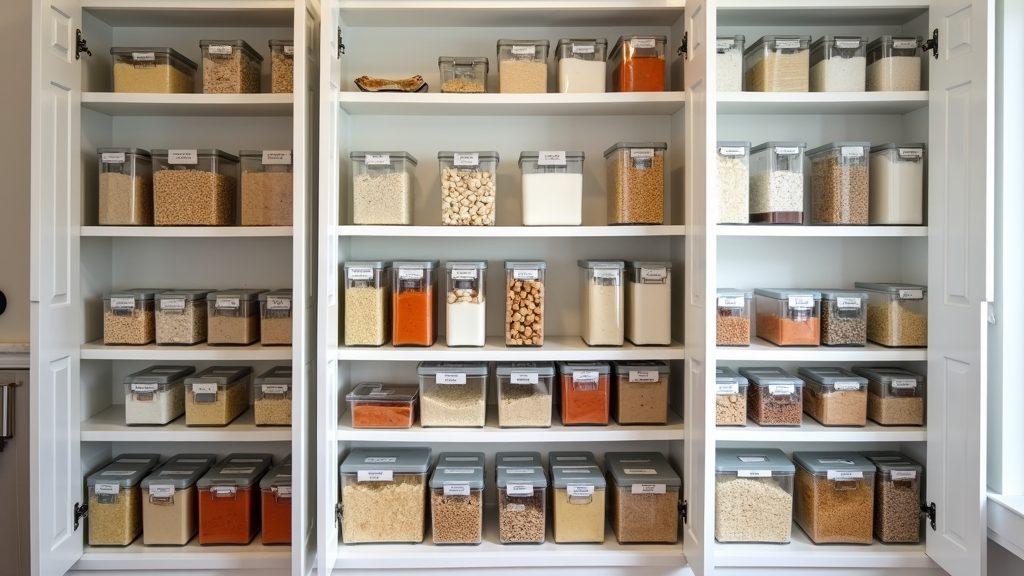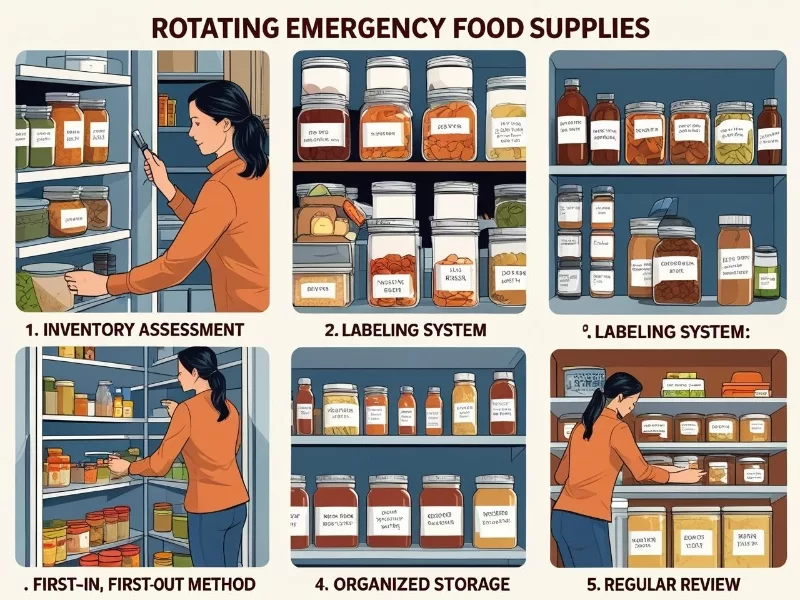Table of Contents
- 1 Fundamental Techniques for Effective Food Storage Rotation
- 2 Getting Started with Food Storage Rotation
- 3 Important Factors to Consider While Rotating Your Food Storage
- 4 Advanced Tips and Tricks for Organizing Food Storage
- 5 Food Storage Basics: What Should Beginners Focus On?
- 6 Frequently Asked Questions
- 7 Extra Insights and Practical Tips
- 8 Conclusion
I have always found that rotating your food storage effectively is a practical way to reduce waste and keep everything fresh. When I first started organizing my pantry, I quickly realized that a good rotation system helps me make the most of my supplies while saving money and time. The experience taught me valuable lessons in planning and organization that I want to share in this article.

Fundamental Techniques for Effective Food Storage Rotation
Food storage rotation involves managing your pantry and other storage areas so that older items are used before they pass their prime. I learned that this system is simply about ordering items by their expiration dates and keeping them visible. A proper rotation system not only helps in preventing spoilage but also supports a smoother meal planning process.
When I first adopted these techniques, I stumbled upon many benefits. For one, it minimizes waste, saving both money and resources. Additionally, an organized pantry provides clear insights into what you have, ensuring you are not purchasing duplicate items. The key is to stay consistent with your approach. Even a routine that once felt overwhelming can become second nature with a little practice and smart planning.
Getting Started with Food Storage Rotation

Before I got too deep into more advanced methods, I started with the basics. It is essential to review all stored items and understand how the food rotates in your home. I found it helpful to categorize items based on when they were bought and their expected shelf life. Here are some initial steps that I followed:
- Assess Your Inventory: I began by taking stock of all foods in my pantry, freezer, and refrigerator. This process made it clear which items were in need of the rotation system.
- Set Up a Labeling System: I started labeling containers with dates and used markers to write the purchase or expiration dates. This simple step helped me quickly identify which items needed to be moved forward.
- Implement the First-In, First-Out Method: I arranged items so that the ones bought first were in front. This first-in, first-out principle is a common strategy that ensures older products are used before newer ones.
- Organize Storage Areas: I dedicated specific shelves or sections in my storage areas for items nearing their expiration. This organization avoids confusion and makes it easier to plan your meals around what needs to be used.
- Regularly Review Your Storage: Every few weeks, I take time to check how items are rotating and adjust as needed. Routine reviews help keep the system functioning smoothly.
These initial actions set a strong foundation. With routine attention, food storage rotation becomes an intuitive part of organizing your home, making meal planning and grocery shopping a much simpler process.
Important Factors to Consider While Rotating Your Food Storage

While implementing a system, there are some factors to keep in mind to ensure that everything remains organized and items are used efficiently. I encountered several challenges and learned ways to overcome them with careful planning.
- Shelf Life and Expiration Dates: Different items have varying shelf lives. Dry goods may last longer than dairy or fresh produce, so keeping track of these differences is key.
- Packaging Quality: I noticed that the condition of the packaging plays a role in how certain foods are stored. Containers with secure seals help maintain freshness, especially for items that are stored for longer periods.
- Environmental Conditions: Temperature, humidity, and light all affect food shelf life. When I rearranged my pantry, I ensured that sensitive items were stored in cooler, darker areas to extend their usability.
- Space Utilization: Effective organization depends on using the available space wisely. I made sure that the layout of my storage areas allowed for easy access and clear visibility of all items.
Shelf Life
Understanding the shelf life of various foods is really important. I always check expiration dates and note that some items, like canned goods, have much longer periods for use compared to fresh produce. Creating separate zones based on these timelines has saved me from having to deal with spoiled items, and it has allowed me to plan my cooking around items that should be used soon.
Environmental Conditions
The layout and storage environment greatly affect the quality and longevity of your food. I have found that placing sensitive items in areas with stable, cool temperatures is a practice that reduces waste. For example, items like oils and flour do not need exposure to heat or sunlight. Adjusting your storage environment helps maintain the quality of your items over time.
Being mindful of these factors prompted me to revisit and adjust my storage setup several times. The experience underlined the fact that a one-time setup is rarely enough. Over time, as my storage needs changed with seasonal variations and different purchasing habits, I continued to refine my method consistently.
Advanced Tips and Tricks for Organizing Food Storage
Once I had the basics down, I wanted to jump into advanced techniques to further streamline the storage rotation process. Taking advantage of more sophisticated strategies made my system even more efficient and easier to maintain on busy days.
Use Inventory Management Tools: I started using simple spreadsheets or mobile apps to keep track of my inventory. These tools helped me monitor expiry dates and quantities easily. Although this step sounded complex at first, it soon became a natural part of my routine.
Improve Visibility with Transparent Storage: I switched to using clear containers so that I could immediately see labels and contents. This change allowed me to assess which items needed to be used sooner without having to open every container.
Create Zones for Different Food Types: I divided my storage into sections based on the type of food. Separating items like grains, canned goods, and snacks not only saved time when searching for something specific, but it also made cleaning and organizing easier. Each zone served as a mini system for rotation.
Plan Regular Audits: I set aside days every month to go through my storage for items that were nearing their expiration. These audits meant I could plan meals around using up those items, thus integrating the rotation process with meal planning. This advanced habit proved very beneficial and kept my pantry in excellent shape.
Adopt a Rotating Racks System: For those with larger storage spaces, installing rotating racks or lazy susans can help. I found that rotating racks make it easier to reach items at the back and ensure that nothing is forgotten. Using these racks helps me maintain a consistent flow from the oldest to the newest items.
The advanced techniques I adopted not only optimize the way food is stored but also reduce the daily stress of managing a busy household. With these practical approaches, organizing food storage becomes both effective and worry-free.
Food Storage Basics: What Should Beginners Focus On?
When I first explored food storage rotation, I realized that keeping the system simple was very important. Beginners should focus on the basics before moving on to more complex arrangements. A solid foundation in basic organization goes a long way.
It is best to start with key items that require special attention. Be sure to check all items for expiration dates and organize them based on how soon they need to be used. For me, establishing a front-to-back rotation system where items closer to expiration are placed at the front helped me quickly adapt to this process.
An important aspect of the basics is the easy setup of a dedicated rotation area. I reserve a specific shelf or section of my pantry for items that need to be prioritized. This simple practice ensures that these products are always visible and serve as a constant reminder to use them before opening new packages.
I learned that even small changes in your routine can make a big difference. Allocating time once a week to review your food storage allows you to catch items that might have been overlooked and plan your grocery list around what truly needs to be used.
- Monitor Expiration Dates: It is essential to keep track of product expiration dates, especially for perishable items. I always mark these dates when I first open a package.
- Rotate Regularly: Even a slight reordering of items at the end of each week can help prevent waste. I make it a habit to rearrange things every few days.
- Keep It Simple: Rather than overcomplicating the system, I maintain clear categories and simple storage rules. This simplicity ensures that the entire family can follow the rotation system without confusion.
Starting with these basic strategies forms a consistent routine. As you become more comfortable with the system, you may find opportunities to incorporate advanced methods. The key is to keep the basics streamlined and effective.
Frequently Asked Questions
I get a lot of questions about food storage rotation. Here are some of the common queries that I have encountered along the way:
Question: How often should I rotate my food storage?
Answer: I usually check and rotate my stock every week. This frequency keeps older items in view so they are used before newer purchases. Depending on your usage and the types of foods you store, adjustments might be necessary.
Question: What should I do if I notice a product nearing its expiration date?
Answer: I prefer to plan meals or use the item as soon as possible to avoid any waste. Labeling items right when they are bought can help remind you to use them in time.
Question: How can I reduce packaging waste during food storage rotation?
Answer: I sometimes transfer items to reusable containers, especially for products that come in bulky packaging. This not only helps in rotating the stock efficiently but also minimizes waste over time.
Question: What are some tips for maximizing storage space while still keeping a rotation system?
Answer: I find that clear labels, grouping similar items together, and using shelf organizers work very well. Rotating racks or lazy susan designs can also optimize space, making it easier to access older items.
Extra Insights and Practical Tips
Expanding on what has already been discussed, here are some extra insights that have really helped me manage my food storage more efficiently. First, regularly updating your inventory list can save you time and prevent duplicate purchases. I keep a notebook in my pantry and also use a mobile app for quick updates. This practice ensures that I always have an accurate snapshot of what is available at any moment.
Another practical tip is to group your food storage items by type. For instance, keep baking supplies in one section, snacks in another, and canned goods together. This organization helps you find what you need faster and simplifies the process when planning meals. Additionally, consider seasonal variations. In the summer, you might notice certain perishable items need more frequent checks, whereas in the winter, long-life items may dominate your inventory.
Budgeting for food purchase can also be intertwined with your rotation system. By knowing what you already have and planning meals accordingly, you can reduce unnecessary expenses. This approach not only helps in managing food storage but also contributes to a healthier financial lifestyle.
It is also beneficial to set aside time each month for a thorough audit of your pantry. This is when you double-check expiration dates, remove obsolete items, and reorganize shelves if needed. Going through these items in detail can provide fresh ideas on how to optimize your space even further.
Finally, sharing these strategies with family members encourages everyone to participate. When everyone knows the system, meal planning becomes a shared adventure rather than a single person’s task. The more involved each family member is, the smoother the rotation system operates, resulting in less waste and a more organized kitchen.
Conclusion
Rotating your food storage effectively is a practical skill that pays off by reducing waste, saving money, and ensuring that your kitchen is always stocked with fresh ingredients. I have found that establishing simple yet effective systems makes a huge difference in daily routines. Whether you are just beginning or have plenty of experience, these methods step up the overall management of your food supplies.
The process may seem detailed at first. With consistency, it becomes an integral part of running a household. Over time, I have observed that a proactive approach to food storage rotation helps avoid unnecessary waste and makes meal planning more efficient. I encourage anyone who manages a kitchen to take a closer look at how items are stored. Every small effort counts. By planning ahead and occasionally revisiting your system, you set the stage for a hassle-free cooking experience.
Embracing food storage rotation is a straightforward practice that brings lasting benefits. What truly matters is the effort to remain organized and the readiness to adjust as circumstances change. With the right approach, you can enjoy a well-organized pantry that saves time and reduces food waste. The ride toward a more efficient home starts with small, deliberate steps. Over time, even minor adjustments in food storage habits can lead to a big change in your daily routine. Bottom line: being proactive with your pantry can truly transform everyday cooking into a stress-free and enjoyable adventure.

The discussion on efficient food storage rotation really got me thinking about how these strategies can be adapted for various household setups. The focus on preventing waste while maintaining freshness is particularly engaging. I’m curious – have you experimented with any digital tools or apps that help track expiry dates in real time? Also, how do you suggest handling situations where different types of food items require different rotation schedules? It would be interesting to learn if you’ve observed any challenges when applying these methods during seasonal fluctuations or supply chain issues.
Thank you for your thoughtful comments! I’m happy to hear that the discussion on efficient food storage rotation resonated with you. It really sounds like you have put a lot of thought into the topic as well.
Some popular apps include:
HNGRY: This app allows you to know what’s in stock, check shelf life, and reduce food waste.KitchenPal: A comprehensive app for pantry tracking, barcode scanning, and shared grocery lists.FoodKeeper: This app provides guidance on food storage and helps you use items while they are at peak quality.
As far as rotation schedules are concerned about the best I could suggest is to group like foods together, perishables separate from non-perishables, keep an accurate labeling system, and do regular checks to make sure items are being rotated on schedule.
When it comes to seasonal fluctuations and supply chain issues, your best bet would to be to remain flexible in your stock, and I would recommend finding adequate substitutions for when supplies are not as readily available as we would like for them to be.
I hope these suggestions have helped you to further brainstorm!
This article really opened my eyes to the art of preserving green tea’s full flavor and benefits. I hadn’t realized how much factors like light, air, and moisture can impact every sip. Your practical tips on choosing the right containers and even considering vacuum-sealing have inspired me to rethink my own tea storage habits. It’s amazing how a few thoughtful changes can transform a simple cup of tea into a truly refreshing experience. Thanks for sharing such an insightful guide!
Hi Dan!
Thank You for your comments!
It’s great to hear that you’re inspired to rethink your own tea storage habits. I’m glad you found the information helpful and insightful!
It’s always a good thing when people are inspired to learn more about food preservation. It’s really not just about emergency planning but something that will go a long ways towards more useful planning as a normal routine!